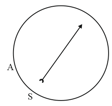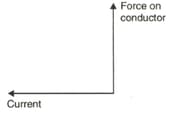Force on a Current-carrying Conductor Placed in a Magnetic Field
Force on a Current-carrying Conductor Placed in a Magnetic Field: Overview
In this topic, the force acting on a current-carrying conductor in a magnetic field is explained. The given experiment helps you understand the concept in a better manner.
Important Questions on Force on a Current-carrying Conductor Placed in a Magnetic Field
An electron moves up the page along the plane of paper and crosses a perpendicular magnetic field, which is acting along the plane of paper from left to right. The direction of the magnetic force experienced by an electron is:
A current-carrying conductor does not experience any force, when it is placed in a magnetic field:
When a current-carrying conductor is placed in a strong magnetic field, the direction of force is determined by
In a current-carrying conductor, the direction of magnetic field is determined by
Name the three factors on which the force on the current-carrying conductor depends.
State the rule to determine the direction of force experienced by a current-carrying conductor in a magnetic field. How will this force get affected on reversing the direction of current flow?
Describe the activity that shows that a current-carrying conductor experiences a force perpendicular to its length and the external magnetic field. How does Fleming's left hand rule help us to find the direction of the force acting on the current-carrying conductor?
A magnetic compass shows a deflection when placed near a current-carrying wire. How will the deflection of the compass get affected if the current in the wire is increased? Support your answer with a reason.
A magnetic compass needle is placed in the plane of paper near point as shown in figure. In which plane should a straight current-carrying conductor be placed so that it passes through and there is no change in the deflection of the compass? Under what condition is the deflection maximum and why?

(a) Describe an experiment with a diagram to show that force is exerted on a current-carrying conductor when placed perpendicular in a magnetic field.
(b) How will this force change if current in the conductor is increased?
(c) Name a device that uses the above principle.
(a) Which rule helps to find the force on a current-carrying conductor in a magnetic field?
(b) State the rule.
Describe with the help of a labelled diagram an activity to demonstrate the force acting on a current-carrying conductor due to a magnetic field.
Under what condition does a current-carrying conductor kept in a magnetic field experience maximum force? On what other factors does the magnitude of this force depend? Name and state the rule used for determination of direction of this force.
State the rule to determine the direction of force experienced by a current-carrying conductor in a magnetic field. How will this force get affected by doubling the magnitude of current?
Why does a current-carrying conductor kept in a magnetic field experience force? On what factors does the direction of this force depend? Name and state the rule used for determination of direction of this force.
State the direction of magnetic field in the following case.
Why does a current-carrying conductor kept in a magnetic field experience force? What is the direction of force acting on the conductor?
On what factors does the magnitude of magnetic field by a current-carrying solenoid depends?
Under what conditions does a moving charge experience:
(i) Maximum force?
(ii) Minimum force?
State Fleming's left hand rule. A positively charged particle projected towards west is deflected towards north by a magnetic field. Find the direction of magnetic field.

